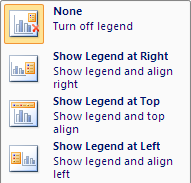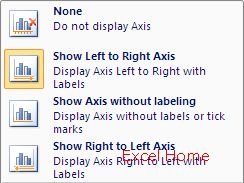- excel表格制作教程:Excel图表添加水平线
- excel函数教程:Excel“关系或”条件的高级筛选
- excel vba教程:VLOOKUP使用技巧之按指定次数重复数据
- excel函数教程:把数据合并到一个单元格,这效率太高了
Charting III – Tabs and Templates
In the previous two charting posts, I wrote about how you can make a professional chart with four simple choices – chart type, chart layout, chart style, and document theme. As useful as we hope that is, we know that some users will want to tweak and control every aspect of their charts. Today I want to walk through the tabs that are available when you are working with a chart and provide an overview of all the capabilities that are exposed in the ribbon. I am also going to briefly cover templates.
图表三:选项卡和模板
在前两个贴子里,我写了如何通过4个简单步骤创建专业图表:图表类型、图表版式、图表样式、文档主题。希望对你有益。我们知道有些用户想从各个方面来调节图表。今天我想通过ribbon上的图表选项卡来介绍图表设置。我也会简要介绍一下模板。
Design Tab
When you are working with a chart, three additional contextual tabs will be available – Design, Layout, and Format. Here is a shot if the Design Tab.
设计选项卡
当你制作图表时,有三个选项卡可用:设计、样式、格式。下图是设计选项卡。

(Click to enlarge)
The Design tab allows users to set the style and layout of a chart. In addition, this is where you change the chart type, change the data source, move the chart, and a few other things. The bulk of this was covered in previous posts.
用户可以通过设计选项卡设定图表版式、图表样式。此外,还可改变图表类型,改变数据源,移动图表及其他一些设定,大多数在以前的贴子中介绍过。
Layout Tab
The chart layout tab contains easy access to the various elements of a chart – title, legend, axes, series, data labels, etc. Each element has its own gallery of simple choices to construct charts. Most of these choices were available in previous versions of Excel, but you had to find the correct dialog to use them. With the ribbon, these choices are much more accessible and results-oriented.
版式选项卡
图表版式选项卡可以方便地设置各种图表元素:标题、图例、轴、数据系列、数据标志等。每个图表元素都可以从自己的图形目录中选取样式,大多数选项在以前的Excel版本中已经使用了,但你必须找到正确的对话框来使用。现在用ribbon有更多的选择和预览效果。

(Click to enlarge)
Here are examples – one for legends, and the one for an axis. The legend gallery gives you a choice of places to put the legend. The axis gallery gives you a choice of how you would like to see the axis. Other galleries give choices for data label position, category axis direction, and gridline patterns.
有两个例子:一个是图例的,一个是轴的。从图例图形目录中可以选择图例的位置,从轴图形目录中可以选择可见的轴。其他图形目录还可选择数据标志的位置,分类轴方向和网格线模式。


(Click to enlarge)
Note that the galleries have a “More Options …” choice at the bottom. The goal of the galleries is to make it easy to apply common settings with one click. Since not every capability would fit in these galleries, so there is still a format dialog for each chart element, much like in previous versions of Excel, which is launched when the user selects “More Options …” This gives the user the finest level of control over the features. (The format dialog is now modeless, so you can click to other elements and change their formatting. Also, the choices have also been rearranged somewhat, trying to make them fit better together.)
注意图形目录最下面有个”更多选项…”,使用图形目录的目的是通过一次点击方便地进行设置。因为不是每功能都能放在图形目录中,所以针对每个图表元素还设置了一个格式对话框。当用户点击”更多选项…”时就会出现对话框,象以前Excel版本似的,这可以充分发挥用户的设置格式水平。(格式对话框是非模态对话框,可以点击其他元素并设置格式。这些选项也可以重新排列,试试排列得更合适些。)
By now, you are probably getting a sense as to the “three level” approach that the ribbon affords us. At the top level, users can select from galleries on the Design tab (chart layout, chart style) that to create a wide variety of charts very simply. If users then want to do more detailed tweaking, they can move to the Layout tab, where they can manipulate the objects on the chart, again using very visual, results-oriented galleries. And, for those folks that want even more fine-grained control, there are modal dialogs with every available setting.
现在,你大概就越来越感到ribbon 提供的”三个层次”的方法。最高层,用户可以在设计选项卡的图形目录里选择(图表版式,图表样式) 非常简单地创建各种图表;如果用户想进行更细的设置,可以转到图表样式选项卡中,再利用非常直观、预览结果的图形目录设置图表上的对象;如果要进行更细致的设置,可以通过格式对话框进行各种设定。
上一篇:excel表格制作:永恒的Excel间隔底纹 下一篇: 数据透视表IV――任务向导用户界面
郑重声明:本文版权归原作者所有,转载文章仅为传播更多信息之目的,如作者信息标记有误,请第一时间联系我们修改或删除,多谢。



